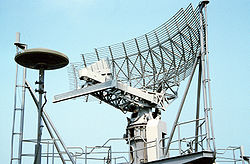 AN/SPS-49 on USS Abraham Lincoln | |
| Country of origin | United States |
|---|---|
| Introduced | 1975 |
| No. built | 200+ |
| Type | 2D Air-search |
| Frequency | L band 851–942 MHz |
| Range | 3 nmi (5.6 km) to 256 nmi (474 km) (AN/SPS-49A(V)1) |
| Altitude | up to 150,000 ft (45,720 m) |
| Diameter | 24 ft (7.3 m) × 14 ft 3 in (7.3 m × 4.3 m) |
| Azimuth | 0 to 360° |
| Precision | 1/16 nmi range 0.5 deg azimuth (SPS-49A(V)1) |
| Power | 360 kW peak, 13 kW average (AN/SPS-49A(V)1) |
The AN/SPS-49 is a United States Navy two-dimensional, long range air search radar built by Raytheon that can provide contact bearing and range. It is a primary air-search radar for numerous ships in the U.S. fleet and in Spain, Poland, Taiwan aboard Oliver Hazard Perry-class frigates, Canada on its Halifax-class frigate (prior to FELEX mid-life upgrade) and New Zealand on its Anzac-class frigates. It formerly served in a complementary role aboard Aegis cruisers with the AN/SPY-1 but the systems are currently being removed during routine upgrade with no replacement.
Contents
In accordance with the Joint Electronics Type Designation System (JETDS), the "AN/SPS-49" designation represents the 49th design of an Army-Navy electronic device for surface ship search radar system. The JETDS system also now is used to name all Department of Defense electronic systems.

